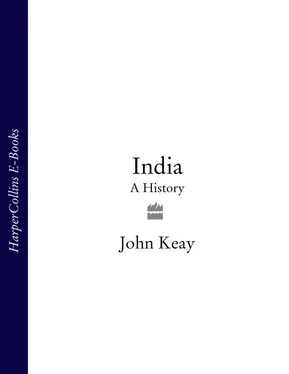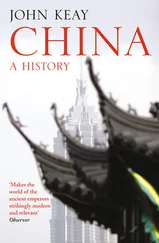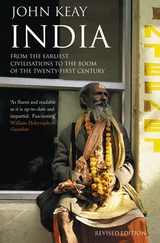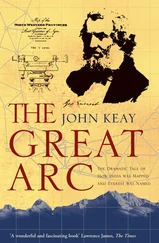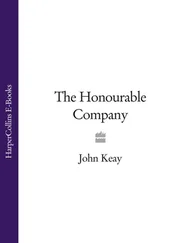Whilst paying homage to architecture in particular, this is not, then, a cultural history of India, let alone a history of Indian cults. If it has a bias, it is in favour of chronology, of presenting such information as is available in a moderately consistent time sequence. This might seem rather elementary; but chronology is often a casualty of the interpretative urge which underlies much Indian history-writing. Whole centuries of no obvious distinction are cheerfully concertina-ed into oblivion, while their few ascertainable productions are either anticipated in an earlier context or reserved for inclusion under some later heading. If, as many authorities now concede, the Arthasastra of Kautilya, a manual of statecraft by the Indian Machiavelli, was not compiled in the fourth – third centuries BC, then our whole idea of the nature of authority during the great ‘imperial age’ of the Maurya kings (C320–180 BC) needs revision. Likewise if Kalidasa, ‘the Indian Shakespeare’, did not coincide with the next ‘imperial flowering’ – and only circumstantial evidence suggests that he did – then the ‘golden age of the Guptas’ (C320–500 AD) begins to look somewhat tarnished.
Analysis thrives on a synchronism of evidence which, in such cases, is often hypothetical or contrived. Indeed Indian history is altogether perverse when it comes to clustering. A curious feature of that ‘galaxy of monuments’ is that comparatively few are located around major power centres. Nor can many certainly be credited to pan-Indian dynasties like the Mauryas and the Guptas. The exceptions are the newer cities of Delhi and Agra on which Sultans, Mughals and British all lavished their patronage. But at earlier power centres like Pataliputra (at Patna in Bihar) or ‘imperial’ Kanauj (near Kanpur in Uttar Pradesh), tangible evidence of the great empires which their Maurya, Gupta or Vardhana rulers claimed to control is scarce. Instead, for the earliest temples one must travel more ambitiously to Sanchi or Ellora, Kanchi or Badami, places hundreds of kilometres away in central India, the Deccan and the south.
The traditional explanation for this poor correlation between dominion and architectural extravagance held that Muslim iconoclasts demolished whatever temples and palaces adorned the earlier capitals of northern India. This may have been the case, especially with richly endowed religious centres like Varanasi (Benares) and Mathura (Muttra), but the fact remains that those temple clusters which do survive, as also the great palaces and forts of a later date, are attributable not to high-profile and supposedly all-India rulers like the Guptas or Harsha-vardhana but to lesser (because more localised) dynasties and to the merchants and craftsmen who lived under their protection.
These lesser dynasties, which flourished throughout India during the first and much of the second millennium AD, we know mainly from inscriptions. Unfortunately the inscriptions are couched in such oblique language, the claims they advance contain so much repetition and poetic exaggeration, and the kings and dynasties they mention are so numerous and so confusing, that most histories pay them scant attention. With perhaps twenty to forty dynasties co-existing within the subcontinent at any one time, it would be an act of intellectual sado-masochism to insinuate this royal multitude into a tender narrative, and I have not attempted to do so. But trusting to the reader’s indulgence, I have tried to convey the flavour of their inscriptions and to isolate those dynasts whose claims on our attention are substantiated by other sources or by still gloriously extant memorials.
Without some treatment of this long dynastic fray, gaping holes appear in the record. Compression and selection are the historian’s prerogative, but it is not self-evident, as per several current histories of India, that remote centuries may be ignored because ‘recency has a decided priority’. 3My own experience as an intermittent correspondent and political analyst suggests exactly the opposite. Since most of today’s headlines will be on tomorrow’s midden, ‘recency’ is a deceptive commodity which the historian might do well to approach with caution. In this book, far from sharpening the focus as history blends into the foreground of current affairs, I have intentionally blurred it. Affairs still current are affairs still unresolved.
In contriving maximum resolution for the present, there is also a danger of losing focus on the past. A history which reserves half its narrative for the nineteenth and twentieth centuries may seem more relevant, but it can scarcely do justice to India’s extraordinary antiquity. Nor, simply because the British and post-colonial periods are better documented and more familiar, are they more instructive. There lurks in contemporary-centrism an arrogance no less objectionable than that in Euro-centrism, Occidento-centrism or Christo-centrism. To my mind such selective editing diminishes history. In pillaging the past for fashionable perspectives on the present we deny the delightful inconsequence, the freak occurrences and the human eccentricities which enliven what is otherwise a somewhat sombre record. Honest dealing with the time-scale, as with the spatial environment, is not without its rewards.
If time is the locomotion of history, place could be the gradient against which it is pitted. Dynamic, the one hurtles forward; inert, the other holds it back. Not for nothing are unspoilt landscapes invariably billed as ‘timeless’. Boarding at random an overnight train, and awaking twelve hours later to a cup of sweet brown tea and a dawn of dun-grey fields, the traveller – even the Indian traveller – may have difficulty in immediately identifying his whereabouts. India’s countryside is surprisingly uniform. It is also mostly flat. A distant hill serves only to emphasise its flatness. Distinctive features are lacking; the same mauve-flowered convolvulus straggles shamelessly on trackside wasteland and the same sleek drongos – long-tailed blackbirds – festoon the telegraph wires like a musical annotation. It could be Bihar or it could be Karnataka, equally it could be Bengal or Gujarat. Major continental gradations, like west Africa’s strata of Sahara, sahel and forest or the North American progression from plains to deserts to mountain divide, do not apply. The subcontinent looks all of a muchness.
THE PEAKS AND TROUGHS OF DOMINION
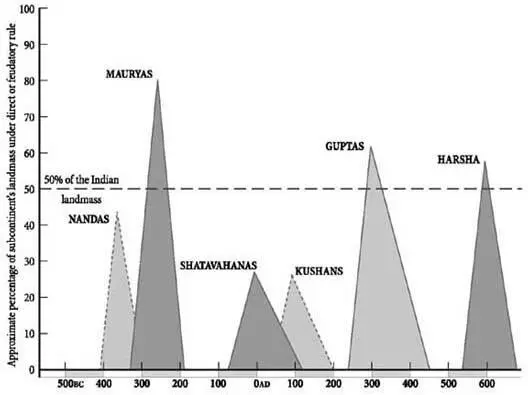
There are, of course, exceptions; in India there are always exceptions, mostly big ones. The Himalayas, the most prominent feature on the face of the earth, grandly shield the subcontinent from the rest of Asia; likewise the Western Ghats form a long and craggy rampart against the Arabian Sea. Both are very much part of India, the Himalayas as the abode of its gods, the Ghats as the homeland of the martial Marathas, and both as the source of most of India’s rivers. But it is as if these ranges have been pushed to the side, marginalised and then regimented like the plunging V of the south Asian coastline, so as to clear, define and contain the vast internal arena on which Indian history has been staged.
An instructive comparison might be with one of Eurasia’s other subcontinents – like Europe. Europe minus the erstwhile Soviet Union comprises about the same area as the Indian subcontinent (over four million square kilometres). But uniform and homogeneous it is not. Mountain chains like the Alps and the Pyrenees, plus a heavily indented coastline and a half-submerged continental shelf, partition the landmass into a tangle of semi-detached peninsulas (Iberia, Scandinavia), offshore islands (Britain, Ireland) and mountain enclaves (Switzerland, Scotland). The geographical configuration favours separation, isolation and regional identity. Corralled into such natural compartments, tribes could become nations and nations become states, confident of their territorial distinction.
Читать дальше
